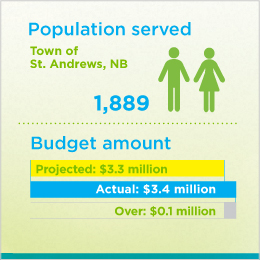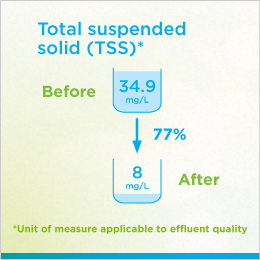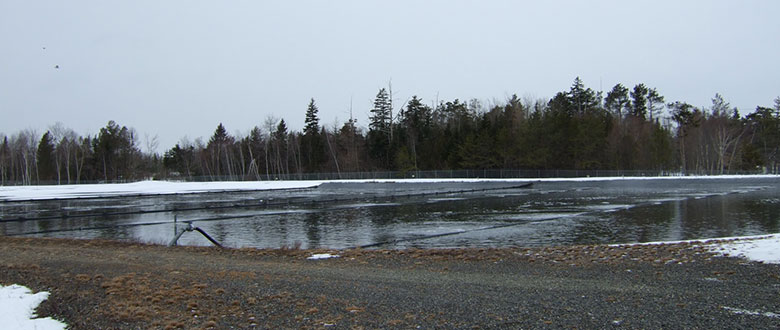This is part of a series of case studies on wastewater projects funded by the FCM's Green Municipal Fund. Each case study provides technical information, project details and tips on best practices.
Project overview
The Town of St. Andrews, NB, upgraded its wastewater treatment plant to meet environmental standards, improve quality of life for residents and create capacity for growth. To increase capacity while minimizing costs and the environmental impact of construction, the town chose to make one of its two existing facultative treatment ponds deeper and add a lining to the pond, rather than build a new pond. The town also introduced submerged aeration and UV disinfection systems and installed a monitoring and control system. The upgrades are part of a broader, ongoing wastewater plan that includes separating the town's storm sewer connections from its sanitary collection system and encouraging citizens to remove foundation drains from their sanitary sewer service lines.



Reasons for the project
- The town needed to increase the capacity of its wastewater treatment plant to allow for growth.
- Some equipment was reaching the end of its service life.
- The system was not in compliance with Wastewater Systems Effluent Regulations and standards set by the New Brunswick Department of Environment and Local Government.
Innovative aspects of the project
- The upgrades will lead to significant improvements in the watershed and allow the community to grow in a sustainable manner.
Best practices and key lessons
The municipality's experience with this project demonstrates some best practices and key lessons that can inform similar projects.
Engage early and broadly
- The town met with the provincial Department of Environment and Local Government early on to gain support, expedite the permitting process and learn from its expertise.
- During the scoping stage, the town engaged with local residents to explain the project and its benefits and obtain feedback. The town ended up modifying the design to address residents' concerns.
- For a small municipality, obtaining community buy-in and support is particularly important when a project involves borrowing funds or increasing user fees to pay for upgrades.
Conduct background research
- As a smaller community, it was important that the town do its own research, rather than simply rely on a consultant, in order to explore a full range of options and make the best choices for the community. The research helped the town identify new technologies, estimate costs and learn from other municipalities' experiences.
Include contingencies in the project budget to avoid schedule delays
- The project was delayed because of weather, contractor delays and cost overruns.
- The bids received by the town were significantly higher than anticipated in the project budget (close to $4 million compared to the budget of $3 million). This was compounded by the fact that the project had been pre-approved by the Building Canada Fund for funding that would cover two-thirds of the original (lower) budget. The town was responsible for all the additional costs, which would have doubled its financial contribution to the project. To move forward, the town worked with the contractor and a design consultant to modify the project design and schedule, reducing costs without sacrificing the integrity of the project.

View of lagoons for Town of St. Andrews, NB, wastewater treatment facility. (Credit: Town of St. Andrews)
Project benefits
This project yielded a number of environmental, social and economic benefits.
Environmental benefits
- Decreased energy use and greenhouse gas emissions: The plant upgrades have yielded a 26 per cent reduction in annual power consumption.
- Improved effluent quality: Water quality now meets regulatory standards.
- Reduced chemical residuals: With the introduction of ultraviolet disinfection, water discharges are now cleaner.
- Protected biodiversity and ecosystem: The quality of the discharge has improved, benefitting the surrounding ecosystem and leading to greater aquatic health.
- Decreased noise pollution: The previous mechanical aerators created an extremely loud howling sound that disturbed neighbours and people in the nearby campground. Replacement of this system has reduced noise pollution in the community.
- Decreased odour pollution: The improvements to the treatment process have eliminated the odours perceived by local residents and pedestrians.
Social benefits
- Protection of public health: The quality of the discharge has improved, benefitting the natural environment and, in turn, improving human health.
- Improved staff health and safety: The upgraded wastewater treatment plant meets health and safety regulations, creating safer working conditions for municipal staff.
- Community beautification: The project improved the aesthetics of the treatment site by making the facility more compatible with its surroundings.
- Improved service delivery: The upgraded plant has a greater water treatment capacity.
Economic benefits
- Decreased operating costs: The plant's upgraded technology is more efficient, reducing operating costs.
- Decreased maintenance costs: The new equipment will be less likely to break down, resulting in less downtime and reduced maintenance costs.
- Increased potential to attract new residents and businesses: The increased wastewater treatment capacity will allow the town to attract new growth and support sustainable development.
- Local business development: The improved effluent water quality may contribute to the return of shellfish harvesting in the local area, which has been suspended for many years due to poor water quality in the Chamcook Lake and the larger Passamaquoddy Bay. In addition, increased presence of larger marine life, such as sea birds and whales, will attract visitors and may represent a source of income for local tour boat operators.

Technical highlights
This project was a new facility. Technical highlights are current as of 2013.
Municipal population: 1,889
Urban/rural: rural
Treatment: Aerated lagoon
Disinfection
- Before: None
- After: UV disinfection system — 136CFU/100 ml
Biosolids management: Ponds dredged periodically
Annual average daily flow (AADF)
- Before: 2.1 MLD (million litres per day)
- After: 2.5 MLD
Design capacity
- Before: 1.3 MLD
- After: 2.1 MLD (9.2 MLD is what the system could handle if the recorded influent data were used as a model)
Per cent of total capacity used for AADF
- Before: 161 per cent
- After: 104 per cent
Biochemical oxygen demand (BOD)
- Before: 17 mg/L
- After: 8.2 mg/L
Project contact information
Chris Spear
Treasurer/Deputy Clerk
Town of St. Andrews, NB
T. 506-529-5250
Dan Bartlett
Water & Sewer Technician
Town of St. Andrews, NB
T. 506-529-5255
Want to explore all GMF-funded projects? Check out the Projects Database for a complete overview of funded projects and get inspired by municipalities of all sizes, across Canada.

